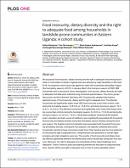| dc.contributor.author | Aziiza, Nahalomo | |
| dc.contributor.author | Per Ole, Iversen | |
| dc.contributor.author | Bård Anders, Andreassen | |
| dc.contributor.author | Archileo, Kaaya | |
| dc.contributor.author | Archangel, Byaruhanga Rukooko | |
| dc.contributor.author | Peter Milton, Rukundo | |
| dc.date.accessioned | 2023-05-25T13:28:31Z | |
| dc.date.available | 2023-05-25T13:28:31Z | |
| dc.date.issued | 2023-04 | |
| dc.identifier.citation | Nahalomo, A., Iversen, P. O., Andreassen, B. A., Kaaya, A., Rukooko, A. B., & Rukundo, P. M. (2023). Food insecurity, dietary diversity and the right to adequate food among households in landslide-prone communities in Eastern Uganda: A cohort study. Plos one, 18(4), e0283078. | en_US |
| dc.identifier.uri | https://doi.org/ 10.1371/journal.pone.0283078 | |
| dc.identifier.uri | https://hdl.handle.net/20.500.12504/1353 | |
| dc.description.abstract | We assessed food insecurity, dietary diversity and the right to adequate food among house-
holds in communities in Eastern Uganda that were affected by major landslides in 2010 and
2018. A prospective cohort study was applied to select 422 households during May-August
(the food-plenty season) of 2019. In January-March (the food-poor season) of 2020, 388
households were re-assessed. Socio-demographic, food security, dietary diversity and right
to adequate food data were collected using structured questionnaires. Four focus groups
discussions and key informant interviews with 10 purposively sampled duty-bearers
explored issues of food insecurity, dietary and the right to adequate food. The affected
households had significantly higher mean (SE) food insecurity scores than controls, both
during the food plenty season: 15.3 (0.5) vs. 10.8 (0.5), and during food-poor season: 15.9
(0.4) vs. 12.5 (0.0). The affected households had significantly lower mean (SE) dietary diversity scores than controls during the food plenty season: 5.4 (0.2) vs. 7.5 (0.2) and during the
food poor season: 5.2 (0.2) vs. 7.3 (0.1). Multivariate analyses showed that the disaster
event, education and main source of livelihood, were significantly associated with household
food security and dietary diversity during the food-plenty season whereas during the food-
poor season, the disaster event and education were associated with household food security and dietary diversity. During both food seasons, the majority of affected and control
households reported to have consumed unsafe food. Cash-handout was the most preferred
for ensuring the right to adequate food. Comprehension and awareness of human rights
principles and state obligations were low. The severity of food-insecurity and dietary diversity differed significantly between the affected and control households during both food sea-
sons. Moreover, the right to adequate food of landslide victims faced challenges to its
realization. There is need for policy and planning frameworks that cater for seasonal variations, disaster effects and right to adequate food in order to reduce landslide victims’ vulnerability to food insecurity and poor dietary diversity. In the long-term, education and income diversification program interventions need to be integrated into disaster recovery programs since they are central in enhancing the resilience of rural livelihoods to shocks and stressors on the food system. | en_US |
| dc.language.iso | en | en_US |
| dc.publisher | Plos One | en_US |
| dc.subject | Food insecurity | en_US |
| dc.subject | Dietary diversity | en_US |
| dc.subject | Adequate food | en_US |
| dc.subject | Households | en_US |
| dc.subject | Landslide-prone communities | en_US |
| dc.subject | Eastern Uganda | en_US |
| dc.title | Food insecurity, dietary diversity and the right to adequate food among households in landslide-prone communities in Eastern Uganda: A cohort study | en_US |
| dc.type | Article | en_US |

